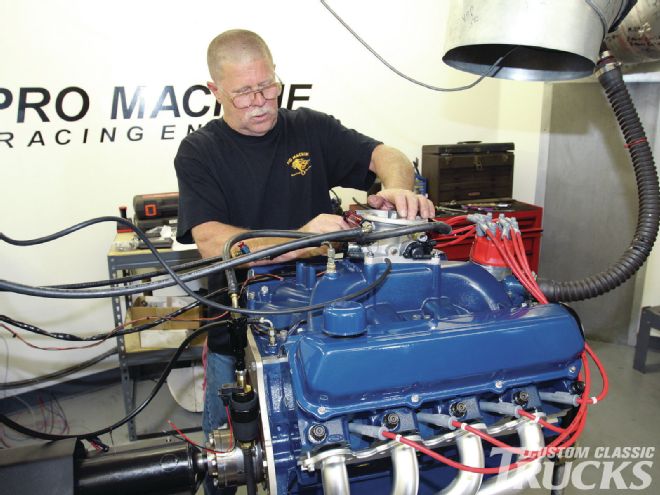
We suspect that for just about anyone firing up a new engine on a dyno for the first time, the anticipation is something akin to buying a lottery ticket—you’re not sure what to expect, but hope for the best. All we can say is we hit the jackpot this time around as our big Ford impressed everyone, including engine builder John Beck of Vintage Hot Rods and Design/Pro Machine, and John’s not the easiest guy on the planet to impress, but we’re getting ahead of ourselves.
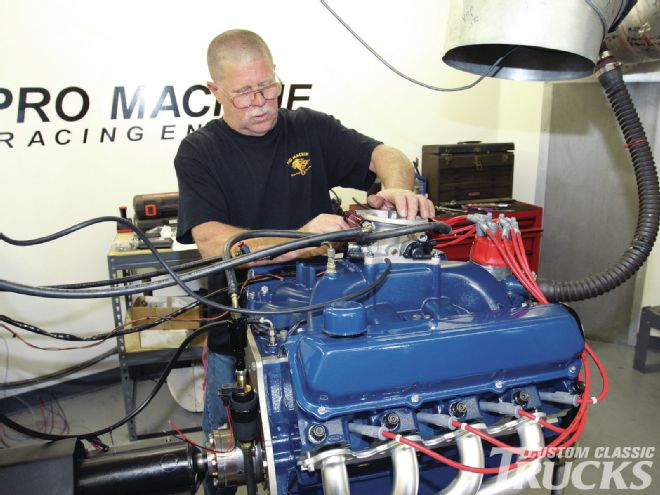 1. John Beck puts the finishing touches on our 545-inch Ford before lighting it off on the dyno for the first time.
1. John Beck puts the finishing touches on our 545-inch Ford before lighting it off on the dyno for the first time.
When it came time to build a fresh engine for the Hot Rod Hauler, our first challenge was finding a good 460 block as our trusty truck’s powerplant had been bored as far as we dared. Ironically a couple of Chevy guys came to the rescue-—Barry Giannoni and Steve Atherton of Barry’s Chevy Parts donated a standard-bore block to the cause. Like the bottom, the top end of our engine had also outlived its usefulness, so we turned to Ford Racing and Performance Parts for a pair of their deep-breathing SCJ aluminum heads. Our goal was an engine that produced stump-pulling torque above all else, so we elected to bump up the displacement with a ½-inch Eagle stroker kit from Summit. The long arm coupled with a .030-inch overbore resulted in 545 cubic inches. We chose a mild Comp Cams roller hydraulic cam and roller rockers, Weiand intake manifold, MSD ignition and Hedman Hedders. All the machine work was done in-house at VHRD/Pro Machine by Russ Beck (no relation to John) and John did the assembly (the details of the build can be found in the October 2012 CCT).
Because we were looking for the utmost efficiency from this engine we topped it off with an EZ-EFI system from FAST. A number of factors influenced our decision, chief among them that no laptop is required and the system is self-learning—it will tune itself as you drive. FAST offers an array of fuel-injection computer kits that can be used to operate OEM factory systems (and ignition), FAST XFI port injection with ignition, 8-stack injectors, or the EZ-EFI with a 4150-style throttle body injector; we chose the latter.
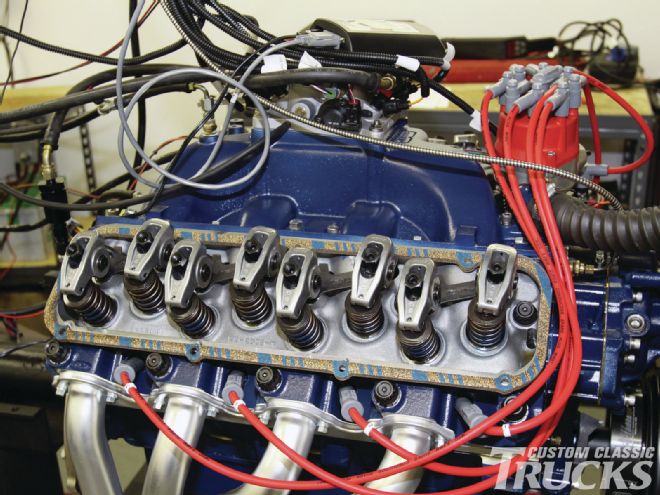 2. We were going for the stealth look and painted the aluminum parts like the Weiand manifold and Edelbrock water pump Ford blue. However, during the assembly process we found the Comp Cams roller rockers wouldn’t clear our powdercoated Transdapt valve covers.
2. We were going for the stealth look and painted the aluminum parts like the Weiand manifold and Edelbrock water pump Ford blue. However, during the assembly process we found the Comp Cams roller rockers wouldn’t clear our powdercoated Transdapt valve covers.
Unlike a conventional four-barrel carburetor, the FAST EZ-EFI throttle body (which may be used in pairs for dual quad systems) operates the four throttle blades simultaneously. There is an electronic injector in each throttle bore and they “bank fire,” which means that one side pulses, or squirts fuel, then the other fires. The computer controls the amount of fuel supplied by adjusting the pulse width, which is computer speak for how long the injectors stay open.
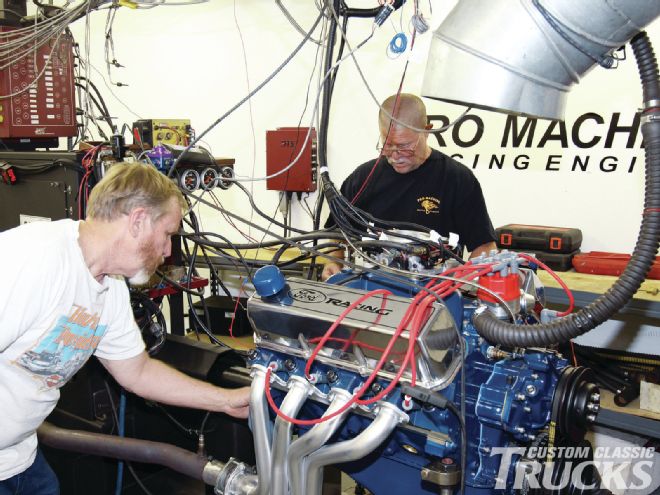 3. Our tin rocker covers were replaced by tall Ford Racing aluminum versions from Summit. Paul Willis made sure we didn’t have any leaks.
3. Our tin rocker covers were replaced by tall Ford Racing aluminum versions from Summit. Paul Willis made sure we didn’t have any leaks.
Like most EFI systems the computer relies on a variety of sensors to control air/fuel ratios:
• Manifold Absolute Pressure Sensor (MAP)—senses load, by reading vacuum and is one of the parameters for adjusting mixture.
• Coolant Temperature Sensor (CTS)—essentially the electronic version of a choke. It tells the computer a richer mixture and fast idle are needed to keep the engine running.
• Air Temperature Sensor (ATS)—it provides one of the parameters for air/fuel ratio. Hotter air requires a leaner mixture; cooler air a richer mixture.
• Throttle Position Sensor (TPS)—acts like an accelerator pump, and provides the computer with additional information. Also used to establish shift points for computer-controlled automatic transmissions.
• IAC Idle Air Control—it controls an air bypass in the throttle body to maintain and adjust idle speed.
• O2 sensor—Ron Turnpaugh from FAST describes it as the eyes and ears of the system. The computer looks at the target air/fuel ratios as read by the O2 sensors and adjusts the delivery of fuel accordingly.
Installing the EZ-EFI couldn’t be “ezier” with the exception of the coolant temperature and the O2 sensors, all the others come installed in the throttle body. The wiring harness is clearly labeled and the Electronic Control Unit, or ECU, is compact making it easy to find a mounting location. A new high-pressure fuel pump is required, and in our case plumbing dual fuel tanks does complicate things a bit, but we’ll show all that when we install the engine.
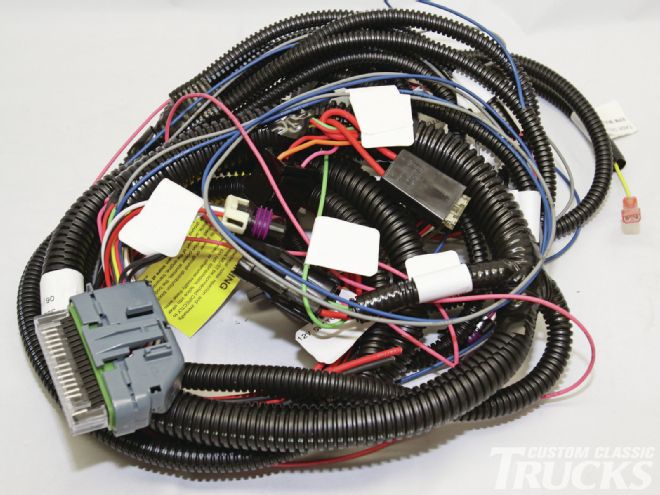 10. The FAST EZ-EFI wiring harness looks intimidating rolled up—but stretched out it becomes obvious that all connections are clearly labeled and will only fit the proper plug.
10. The FAST EZ-EFI wiring harness looks intimidating rolled up—but stretched out it becomes obvious that all connections are clearly labeled and will only fit the proper plug.
The FAST throttle body will bolt in place on any manifold that will accept a 4150-style carburetor, and just like a carburetor, the injector’s performance will respond to the manifold’s design. For operating in the higher rpm ranges a single-plane manifold might be considered. For our purposes we opted for a dual-plane manifold for enhanced low- and mid-range power.
 11. The Setup Wizard is plugged into the ECU and powered up by plugging into 12 volts. Next a series of questions are answered. Here John is scrolling through the displacement screen on the way to 545.
11. The Setup Wizard is plugged into the ECU and powered up by plugging into 12 volts. Next a series of questions are answered. Here John is scrolling through the displacement screen on the way to 545.
Once the system is installed the included Setup Wizard is plugged in—it’s then a matter of answering questions and the ECU does the rest. With the target air/fuel ratios set the system starts out with basic closed-loop operation, which means ECU is comparing readings from the wideband O2 sensor to the targets established for idle, cruise, and wide-open throttle. What happens next is a testament to the sophistication of this system—the ECU then makes corrections by adding or subtracting an amount of fuel to make those two numbers match. The amazing part is the ECU then takes those correction percentages and makes a fuel map based on them. That’s one smart little black box.
From the moment John started the engine on the dyno we all felt our goal was about to be met. After the first pull, saying we’re pleased with our new engine is an understatement and the results speak for themselves. The peaks of 671 lb-ft of torque and 542 horsepower were impressive, but even more so for our purposes are the averages—from 2,500 to 5,000 rpm; 638 lb-ft of torque and 452 horsepower. That’s the makings of a real Hot Rod Hauler. CCT